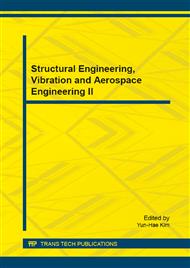[1]
O.T. Thomsen: Journal of Sandwich Structures and Materials, Vol. 11 (2009), p.7.
Google Scholar
[2]
A. Mostafaeipour: Renewable and Sustainable Energy Reviews, Vol. 14 (2010) , pp.1048-1058.
Google Scholar
[3]
C. Gebhardt, S. Preidikman and J. Massa: International Journal of Hydrogen Energy, Vol. 35 (2010), p.6005.
Google Scholar
[4]
M. Liserre, R. Cardenas, M. Molinas and J. Rodriguez: IEEE Transactions on Industrial Electronics, Vol. 58 (2011), p.1081.
Google Scholar
[5]
K. L. Friesth, F. Dodge, U.S. Patent 8, 668, 433. (2008).
Google Scholar
[6]
Li. Zhu, Yiping. Wang and Qunwu. Huang, China Patent 201110241037.X. (2013) [in Chinese].
Google Scholar
[7]
E. Mollasalehi, Q. Sun and W. David: Energies, Vol. 6 (2013), p.3669.
Google Scholar
[8]
P. Jamieson, M. Branney: Energy Procedia, Vol. 24 (2012), p.52.
Google Scholar
[9]
J. S. Christopher, K. T. Judith: IEEE Transactions on Control Systems Technology, Vol. 21 (2013), p.1049.
Google Scholar
[10]
P. Guo, D. Infield: Energies, Vol. 5(2012), p.5279.
Google Scholar
[11]
H. J. Sutherland: Journal of Solar Energy Engineering, Vol. 118(1996), p.204.
Google Scholar
[12]
J. S. Chou, C. K. Chiu, I. K. Huang, et al: Engineering Failure Analysis, Vol. 27(2013), p.99.
Google Scholar
[13]
K. Freudenreich, K. Argyriadi: Wind Energy, Vol. 11 (2008), p.589.
Google Scholar
[14]
J. P. Zhang, D. L. Li, Y. Han, et al: Journal of Vibroengineering, Vol. 15 (2013), p.1597.
Google Scholar
[15]
M. A. Lackner, K. Van and A. M. Gijs: Journal of Solar Energy Engineering, Vol. 132(2010), p.0110081.
Google Scholar
[16]
P. Moriarty: Wind Energy, Vol. 11 (2008), p.601.
Google Scholar
[17]
H. M. Negm, K. Y. Maalawi: Computers and Structures, Vol. 74 (2000), p.649.
Google Scholar
[18]
I. Chowdhury, S. P. Dasgupta: The Electronic Journal of Geotechnical Engineering, 2003, p.8.
Google Scholar
[19]
T. Ackermann, L. Söder: Renewable and Sustainable Energy Reviews, Vol. 4 (2000), p.315.
Google Scholar


